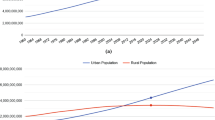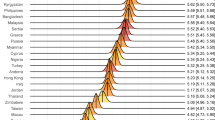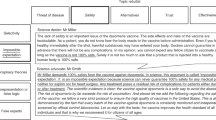Abstract
The American public remains unfamiliar with nanotechnology despite more than a decade of investment and development1. Nanoscientists have an opportunity to contribute to public conversations about their work, and its potential implications, through their engagement with lay audiences and media professionals2. Indeed, the leaderships of many professional scientific organizations have placed a renewed focus on the public communication of science, particularly in the light of drastic changes in the information landscape and the increasing politicization of many technological and scientific issues3,4. However, we have a limited understanding of nanoscientists' perceptions and behaviours regarding their participation in public communication. Here, we report survey results that provide an examination of the public communication behaviours of nanoscientists affiliated with the National Science Foundation's (NSF) National Nanotechnology Infrastructure Network (NNIN), an integrated partnership of US research institutions designed to facilitate nanoscale research and development. Our results suggest that nanoscientists are relatively frequent public communicators who commonly associate their communication efforts with positive impacts on their professional success. We also identify a handful of characteristics that drive nanoscientists' intentions to communicate with the public about nanotechnology.
This is a preview of subscription content, access via your institution
Access options
Subscribe to this journal
Receive 12 print issues and online access
$259.00 per year
only $21.58 per issue
Buy this article
- Purchase on Springer Link
- Instant access to full article PDF
Prices may be subject to local taxes which are calculated during checkout


Similar content being viewed by others
References
National Science Board Science and Engineering Indicators 2014 Ch 7 (National Science Board, 2014); www.nsf.gov/statistics/seind14/
Scheufele, D. A. Nano does not have a marketing problem … yet. Nano Today 2, 48 (2007).
Cicerone, R. Celebrating and rethinking science communication. In Focus 6, 1–2 (2006).
Leshner, A. I. Outreach training needed. Science 315, 161 (2007).
Dudo, A., Dunwoody, S. & Scheufele, D. A. The emergence of nano news: tracking thematic trends and changes in U.S. newspaper coverage of nanotechnology. Journalism Mass Comm. Q. 88, 55–75 (2011).
Berube, D. M. Rhetorical gamesmanship in the nano debates over sunscreens and nanoparticles. J. Nanopart. Res. 10, 23–37 (2008).
Pidgeon, N., Harthom, B. H., Bryant, K. & Rogers-Hayden, T. Deliberating the risks of nanotechnologies for energy and health applications in the United States and United Kingdom. Nature Nanotech. 4, 95–98 (2009).
Siegrist, M. & Keller, C. Labeling of nanotechnology consumer products can influence risk and benefit perceptions. Risk Anal. 31, 1762–1769 (2011).
Tyshenko, M. G., Farhat, N., Lewis, R., Shilnikova, N. & Krewski, D. Applying a precautionary risk management strategy for regulation of nanotechnology. Int. J. Nanotech. 7, 243–264 (2010).
Corley, E., Scheufele, D. & Hu, Q. Of risks and regulations: how leading U.S. nanoscientists form policy stances about nanotechnology. J. Nanopart. Res. 11, 1573–1585 (2009).
Scheufele, D. A. et al. Scientists worry about some risks more than the public. Nature Nanotech. 2, 732–734 (2007).
Besley, J. C. & Nisbet, M. How scientists view the public, the media and the political process. Public Understand. Sci. 22, 644–659 (2011).
Peters, H. P. Gap between science and media revisited: scientists as public communicators. Proc. Natl Acad. Sci. USA 110, 14102–14109 (2013).
Peters, H. P. et al. Interactions with the mass media. Science 321, 204–205 (2008).
Marcinkowski, F., Kohring, M., Fürst, S. & Friedrichsmeier, A. Organizational influence on scientists' efforts to go public: an empirical investigation. Science Comm. 36, 56–80 (2014).
Jensen, P. A statistical picture of popularization activities and their evolutions in France. Public Understand. Sci. 20, 26–36 (2011).
Johnson, D. R., Ecklund, E. H. & Lincoln, A. E. Narratives of science outreach in elite contexts of academic science. Science Comm. 36, 81–105 (2014).
Roco, M. C. & Bainbridge, W. S. Societal Implications of Nanoscience and Nanotechnology (Kluwer Academic, 2001).
Corley, E., Kim, Y. & Scheufele, D. Leading US nanoscientists' perceptions about media coverage and the public communication of scientific research findings. J. Nanopart. Res. 13, 7041–7055 (2011).
Armitage, C. J. & Conner, M. Efficacy of the theory of planned behaviour: a meta-analytic review. Br. J. Soc. Psychol. 40, 471–499 (2001).
Ouellette, J. A. & Wood, W. Habit and intention in everyday life: the multiple processes by which past behaviour predicts future behaviour. Psychol. Bull. 124, 54–74 (1998).
Ajzen, I. The theory of planned behaviour. Org. Behav. Hum. Dec. Proc. 50, 179–211 (1991).
Besley, J. C., Oh, S. H. & Nisbet, M. Predicting scientists' participation in public life. Public Understand. Sci. 22, 971–987 (2013).
Dunwoody, S., Brossard, D. & Dudo, A. Socialization or rewards? Predicting U.S. scientist–media interactions. Journalism Mass Comm. Q. 86, 299–314 (2009).
The National Nanotechnology Initiative Strategic Plan 2007 (National Science and Technology Council, 2007); www.nano.gov/NNI_Strategic_Plan_2007.pdf.
Tsfati, Y., Cohen, J. & Gunther, A. C. The influence of presumed media influence on news about science and scientists. Science Comm. 33, 143–166 (2011).
Dudo, A. Toward a model of scientists' public communication activity: the case of biomedical researchers. Science Comm. 35, 476–501 (2013).
Smith, B. et al. COMPASS: navigating the rules of scientific engagement. PLoS Biol. 11, e1001552 (2013).
Dillman, D. A., Smyth, J. D. & Christian, L. M. Internet, Mail, and Mixed-Mode Surveys: The Tailored Design Method 3rd edn (Wiley, 2008).
Bauer, M. W. & Jensen, P. The mobilization of scientists for public engagement. Public Understand. Sci. 20, 3–11 (2011).
Acknowledgements
This material is based on work supported by a grant from the NSF's NNIN. Any opinions, findings and conclusions or recommendations expressed in this material are those of the authors and do not necessarily reflect the views of the NSF or of the NNIN.
Author information
Authors and Affiliations
Contributions
A.D. and L.K. conceived and designed the survey. N.A., M.C. and A.L. curated the survey. A.D. conducted the analyses. A.D. and L.K. co-wrote the paper.
Corresponding author
Ethics declarations
Competing interests
The authors declare no competing financial interests.
Supplementary information
Supplementary information
Supplementary Information (PDF 426 kb)
Rights and permissions
About this article
Cite this article
Dudo, A., Kahlor, L., AbiGhannam, N. et al. An analysis of nanoscientists as public communicators. Nature Nanotech 9, 841–844 (2014). https://doi.org/10.1038/nnano.2014.194
Received:
Accepted:
Published:
Issue Date:
DOI: https://doi.org/10.1038/nnano.2014.194
This article is cited by
-
How to restore trust in science through education
Nature Physics (2023)
-
Top Indian scientists as public communicators: a survey of their perceptions, attitudes and communication behaviors
Scientometrics (2022)
-
Public communication by climate scientists: what, with whom and why?
Climatic Change (2019)
-
Bustling public communication by astronomers around the world driven by personal and contextual factors
Nature Astronomy (2018)
-
Models of Public Engagement: Nanoscientists’ Understandings of Science–Society Interactions
NanoEthics (2018)



